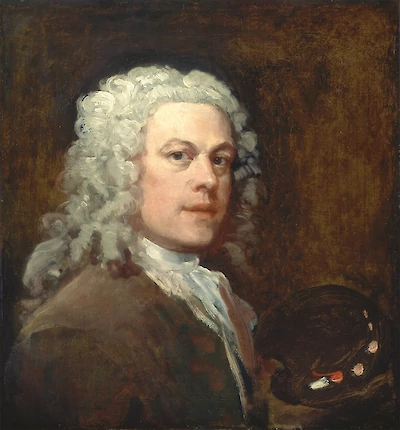

William Hogarth
A printmaker analyzes taste — and beauty comes out on top
1697 – 1764OF COMPOSITION WITH THE WAVING-LINE
There is scarce a room in any house whatever, where one does not see the waving-line employed in some way or other. How inelegant would the shapes of all our moveables be without it! How very plain and unornamental the moldings of cornices, and chimney-pieces, without the variety introduced by the ogee member, which is entirely composed of waving-lines!
Though all sorts of waving-lines are ornamental, when properly applied; yet, strictly speaking, there is but one precise line, properly to be called the line of beauty, which in the scale of them, figure 1, plate 16, is number 4: the lines 5, 6, 7, by their bulging too much in their curvature, becoming gross and clumsy; and, on the contrary, 3, 2, 1, as they straighten, becoming mean and poor; as will appear in figure 2, plate 16, where they are applied to the legs of chairs.
A still more perfect idea of the effects of the precise waving-line, may be conceived from the stay, figure 3, plate 16, which is composed of precise waving-lines, corresponding to line number 4, of figure 1, and is therefore the best shaped stay, deviations from which are shown in the six stays, on plate 17. Every whale-bone of a good stay must be made to bend in this manner, for the whole stay, when put close together behind, is truly a shell of well-varied contents, and its surface of course a fine form; so that if a line, or the lace were to be drawn, or brought from the top of the lacing of the stay behind, round the body, and down to the bottom peak of the stomacher; it would form such a perfect, precise, serpentineline, as has been shown, round the cone, figure 4, in plate 12. For this reason all ornaments obliquely contrasting the body in this manner, as the ribbons worn by the knights of the garter, are both genteel and graceful. Figures 3, 2, 1, and 5, 6, 7, plate 17, are deviations into stiffness and meanness on one hand, and clumsiness and deformity on the other. The reasons for which disagreeable effects, after what has been already said, will be evident to the meanest capacity.
It may be worth our notice however, that the stay, number 2, would better fit a well-shaped man than number 4; and that number 4, would better fit a well-formed woman, than number 2; and when on considering them, merely as to their forms, and comparing them together as you would two vases, it has been shown by our principles, how much finer and more beautiful number 4 is, than number 2; does not this our determination, enhance the merit of these principles, as it proves at the same time how much the form of a woman’s body surpasses in beauty that of a man?
From the examples that have been given enough may be gathered to carry on our observations from them to any other objects that may chance to come in our way, either animate or inanimate; so that we may not only lineally account for the ugliness of the toad, the hog, the bear, and the spider, which are totally void of this waving-line, but also for the different degrees of beauty belonging to those objects that possess it.